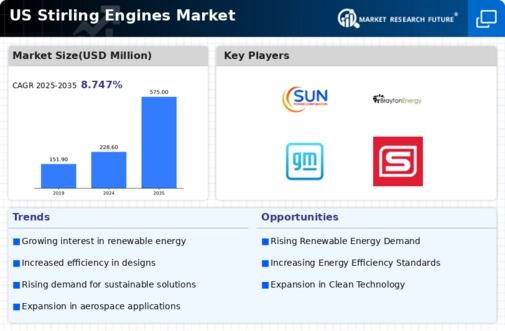Government Incentives and Support
Government initiatives aimed at promoting clean energy technologies are significantly influencing the stirling engines market. Various federal and state programs offer financial incentives, tax credits, and grants to encourage the adoption of renewable energy solutions. For instance, the Investment Tax Credit (ITC) and the Production Tax Credit (PTC) have been instrumental in supporting the deployment of renewable technologies, including stirling engines. These incentives not only lower the initial investment costs but also enhance the economic feasibility of projects utilizing stirling engines. As a result, the stirling engines market is likely to see increased participation from both private and public sectors, fostering innovation and development in this field.
Increasing Focus on Energy Efficiency
The rising emphasis on energy efficiency is a key driver for the stirling engines market. As energy costs continue to rise, both consumers and businesses are seeking solutions that offer better efficiency and lower operational expenses. Stirling engines, with their high thermal efficiency, present a viable option for energy generation and conversion. The stirling engines market is likely to benefit from this trend, as more entities prioritize energy-saving technologies. Furthermore, the integration of stirling engines into existing systems can lead to substantial energy savings, making them an appealing choice for industries aiming to optimize their energy consumption.
Rising Demand for Clean Energy Solutions
The stirling engines market is experiencing a notable increase in demand for clean energy solutions. As environmental concerns intensify, there is a growing shift towards renewable energy sources. Stirling engines, known for their efficiency and low emissions, are becoming a preferred choice for various applications, including power generation and heating. In the US, the market for clean energy is projected to grow at a CAGR of approximately 10% over the next five years. This trend is likely to drive investments in stirling engine technology, as businesses and governments seek to reduce their carbon footprints. The stirling engines market is thus positioned to benefit from this transition towards sustainable energy practices, potentially leading to increased adoption across multiple sectors.
Growing Applications in Various Industries
The versatility of stirling engines is contributing to their growing applications across various industries. From automotive to aerospace and residential heating, the stirling engines market is expanding its reach. The ability to operate on different heat sources, including solar, biomass, and waste heat, makes stirling engines an attractive option for diverse applications. In the US, the automotive sector is particularly interested in integrating stirling engines into hybrid systems, which could enhance fuel efficiency. This trend indicates a potential for significant growth within the stirling engines market, as more sectors recognize the benefits of utilizing this technology.
Technological Innovations in Engine Design
Innovations in stirling engine design and technology are playing a crucial role in shaping the market landscape. Recent advancements have led to the development of more efficient and compact engines, which are suitable for a wider range of applications. For example, improvements in materials and manufacturing processes have enhanced the performance and durability of stirling engines. The stirling engines market is witnessing a surge in research and development activities, with companies investing in next-generation technologies. This focus on innovation is expected to drive market growth, as more efficient engines can lead to lower operational costs and increased competitiveness in the energy sector.















Leave a Comment